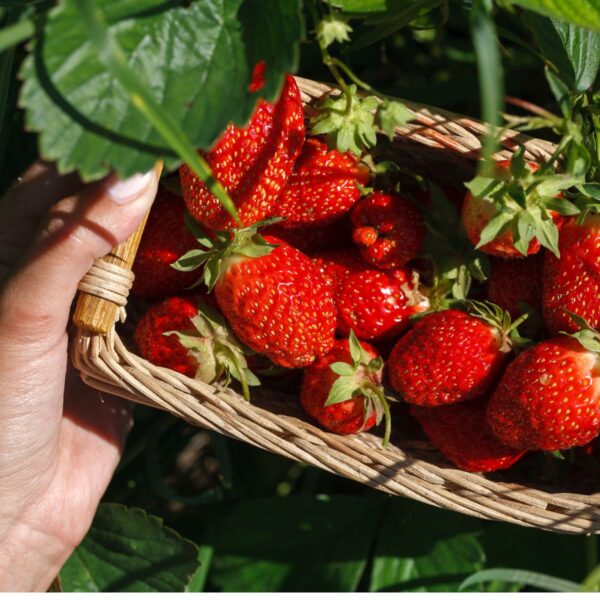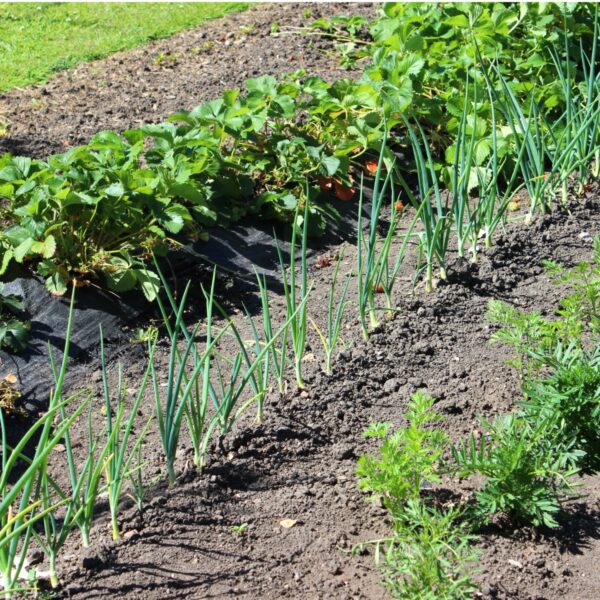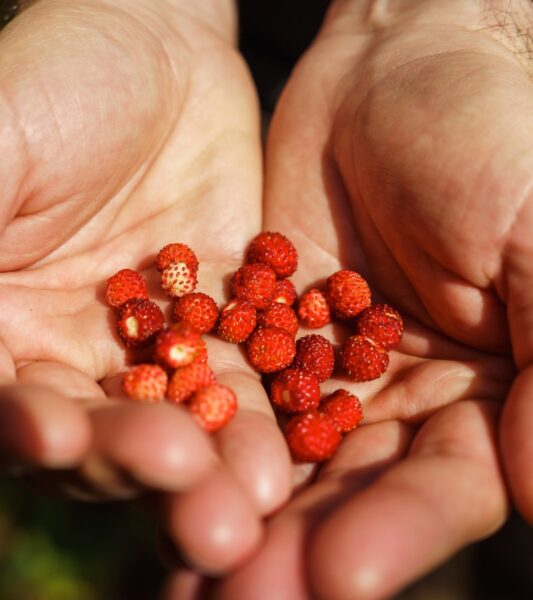Growing your own strawberries will give you that old-fashioned sweetness that is missing in store-bought strawberries. June berries are often considered the sweetest type to grow but the ultimate sweetness is a mix of variety and growing conditions. Here are my favorite super-sweet strawberry varieties and a guide for how to enhance the sweetness beyond just the variety.

Jump to: Sweetest Strawberry Varieties | How To Grow The Sweetest Strawberries | When & How To Harvest | Alpine Strawberries | FAQ
This post may contain affiliate links. As an Amazon Associate, I also earn from qualifying purchases. You can read our disclosure information here–
What Are The Sweetest Strawberry Varieties?
When trying to figure out which strawberry cultivars you should grow if you want super-sweet fruits, it helps to keep in mind that there are three basic types.
Which category a cultivar falls into depends on when its fruits are ripe:
- June-bearing: These strawberry plants produce all of their fruits for the year at once. This can be handy if you grow them for jam-making, for example. You’ll be showered with berries around – you guessed it – June. Produces a lot of runners.
- Everbearing: Unlike what the name suggests, these don’t bear fruit throughout the season. Still, you can expect 2-3 bursts of berries a year. Doesn’t produce as many runners.
- Day-neutral: Bred to bear fruit no matter the number of daylight hours, basically as an improvement to everbearing strawberries, these produce whenever temperatures are right (roughly between 45-90 °F). Great for a steady stream of berries. Doesn’t produce many runners.
Of course, when exactly your strawberries will be ready to pick depends on your climate. Still, this basic categorization will help you choose based on when you want the berries. Or just plant a few of each!
You’d have to be prepared for a veritable tidal wave of strawberries throughout summer, but since they freeze well, that’s not exactly a bad problem to have.

Sweetest Strawberries By Type And Zone
Strawberry sweetness doesn’t depend on the type. All three of the main strawberry categories contain beautifully sweet cultivars, so there really is something for everyone! Most grow well in USDA Zones 3-9, although day-neutrals are considered particularly suitable for warmer climates.
Let’s have a look at the sweetest strawberry varieties in each category. All of these were bred specifically for their high sugar content, so as long as you follow basic strawberry growing guidelines, you’ll get berries that absolutely blow store-bought fruits out of the water.
Sweetest June-Bearing Strawberries
- Honeoye: An old favorite that’s been around for a good while. Great flavor and a nice sweetness. you can buy them from Amazon here.
- Earliglow: If you’ve grown strawberries before, you’ve likely come across this pretty, sweet and easy-care all-around variety. You can buy them from Amazon here.
Sweetest Everbearing Strawberries
- Ozark Beauty: Widely agreed to be the best everbearing strawberry. It ticks all the boxes, including sweetness. You can buy them from Amazon here.
- Quinault: Sweet, vigorous and versatile. Relatively soft berries that you’ll want to eat straight out of the basket. You can buy them from Amazon here.
Sweetest Day-Neutral Strawberries
- Albion: From California. Large, firm and sweet, these are considered fantastic dessert strawberries. You can buy them from Amazon here.
- Sequoia: Sometimes considered everbearing, sometimes day-neutral. Always considered delicious! It’s one of the most popular varieties for home growing.
- Seascape: Large strawberries are often less sweet, but not this one. Firm, glossy and great flavor. You can buy them from Amazon here.
- Diamante: Another fan favorite with big fruits that still retain that real strawberry flavor and excellent sweetness levels.

Did you know? Some strawberries don’t really fit neatly into any of these categories. An example is the ‘Mara Des Bois’, a French creation known for its intense sweetness. When this cultivar fruits is highly dependent on climate.
Alpine Strawberries
The strawberry varieties described above are all scientifically known as Fragaria x ananassa, the domestic garden strawberry. They’re the result of various crosses between different strawberry species and cultivars, plus selective breeding for desirable traits.
There are also still “original” or “wild” strawberry species out there. One of them is the alpine strawberry, Fragaria vesca. Its fruits are much smaller, but they’re also known for being immensely fragrant and sweet, with an intense strawberry flavor.
I grow these small gems in pots combined with other plants. They tumble over the edges of the pots and are really pretty.
I wholeheartedly recommend you try growing a few alpine strawberries along with your domestic cultivars.

Did you know? Fruit and veggie sweetness is measured using something called the Brix scale, which can denote sugar content. You can actually measure it yourself using a refractometer. However, keep in mind that aroma plays an important part as well: according to research, volatile compounds greatly influence flavor perception.
4 Keys to Growing the Sweetest Strawberries
Once you’ve selected the strawberry varieties you’d like to grow, you’ll have to provide the right care in order for them to grow sweet fruits. Luckily, these berries aren’t the most difficult to maintain.
Just follow the basic guidelines for how to grow the sweetest strawberries below and you’re all set!
Fertilizer, Or The Power Of Potassium
One of the most impactful things you can do to ensure your strawberries turn out super sweet is to provide the right kind of fertilizer. As I also discussed in the guide to growing the sweetest blueberries, fruits convert potassium into sugar during their ripening process.
Your strawberries will greatly appreciate a potassium-heavy fertilizer, which can be applied on a regular basis as soon as the plants have started flowering. Potassium is the K (for kalium, its Latin name) in the NPK ratio listed on plant fertilizers.
Special strawberry fertilizers should have plenty of potassium, as will many tomato fertilizers, which may be easier to find locally.
Light
Whether they’re growing in pots or in full soil, it’s important to consider where you put your strawberries. Although most will still produce if they’re in a relatively shaded position, with the exception of alpine strawberries, they love soaking up the sun.
The light is what triggers sugar production, so blast those babies all day long for the sweetest fruits!
Soil
Many strawberry enthusiasts swear by growing these berries in natural soil, stating it just makes them taste better than those grown in potting soil. Unfortunately, that’s not an option for everyone.
If you can’t plant your strawberries straight in the garden, provide a loamy soil with some extra sand added. Include plenty of organic matter, like compost or forest humus, and ensure the mixture is slightly acidic. A pH between 5.5-6.5 should work well.
Water
Since your strawberry plants will ideally be in a full-sun location, their soil will dry out quickly. Don’t let it happen! Give them a good soak every day in the early morning or in the evening (otherwise the harsh sun can burn them).
Strawberries in pots may even need watering twice a day, so just keep checking the soil. Do make sure the containers you use have drainage holes, because standing water can cause root rot.
*Tip: One pound of strawberries will yield about 4 cups hulled or about 3 cups sliced.
When and How To Harvest
When to Pick Strawberries
Harvesting at the right time is key with any fruit! Strawberries should be fully ripe when they’re picked. That means they need to be a uniform red in color, without any green on the shoulders. Firmness depends on the cultivar, but they should definitely not be rock-hard or overly squishy.
It’s best to check your berry plants for ripe fruits daily, like when you water them. Otherwise, the berries might pass their peak and become kind of mushy. Pick them gently to avoid bruising them, leaving some of the stems on.
Interestingly, strawberry growers don’t seem to agree on the best time to pick these berries. Some like to do so in the morning when it’s still cool, while others swear they taste better if they’re picked at the hottest time of day. Honestly, just harvest whenever suits you.
How to Pick
Look for plump, bright red and fully ripe berries, as they do not ripen after they are picked. Caps should be attached, green and fresh looking.
You can pick them with your thumb and forefinger, but be gentle. It is best to harvest with a pair of scissors.

Buying Organic Strawberries
Produce with thin or edible skin is more susceptible to pesticide contamination, and that would be true of strawberries.
Strawberries frequently rank quite high on the Environmental Working Group’s list of the “Shopper’s Guide to Pesticides”, so if your budget allows and you are buying your strawberries, opt for organic.
Nutritional Benefits of Strawberries:
1 cup of strawberries has 3 grams of fiber and more than a full day’s recommended dose of vitamin C, which is an antioxidant that helps keep skin healthy.
Recipes for the Sweet Harvest
A good home-grown strawberry is completely different from the tasteless berries you usually get in the grocery store. Here are a few of my favorite ways to use them:
- Easiest Strawberry Fool
- No-Cook Strawberry Tiramisu Cake
- Greek Yogurt Panna Cotta with Strawberries
- Strawberry Rhubarb Cobbler with Citrus Syrup
- Strawberry Cornmeal Sheet Cake
Frequently Asked Questions
Fresh strawberries don’t last very long: 4-7 days in the fridge. If you can’t eat them all in that time frame, have a look at the best ways to preserve fruits! Discard any berries that show signs of mold, as it spreads quickly to other berries.
Strawberries go dormant, which means they can actually be planted before the threat of frost has fully passed. Just plant them when the soil becomes workable, usually around April, though this of course depends on your local climate.
There are different ways to protect stawberries from different animals. Netting is popular, but you’d have to check it very regularly, as birds can get stuck in it. A wire cage would be a good option as well, and you can also buy natural repellants.
If you like my articles about cooking and gardening, subscribe to my weekly newsletter, where I share free recipes and gardening tutorials.


Leave a comment